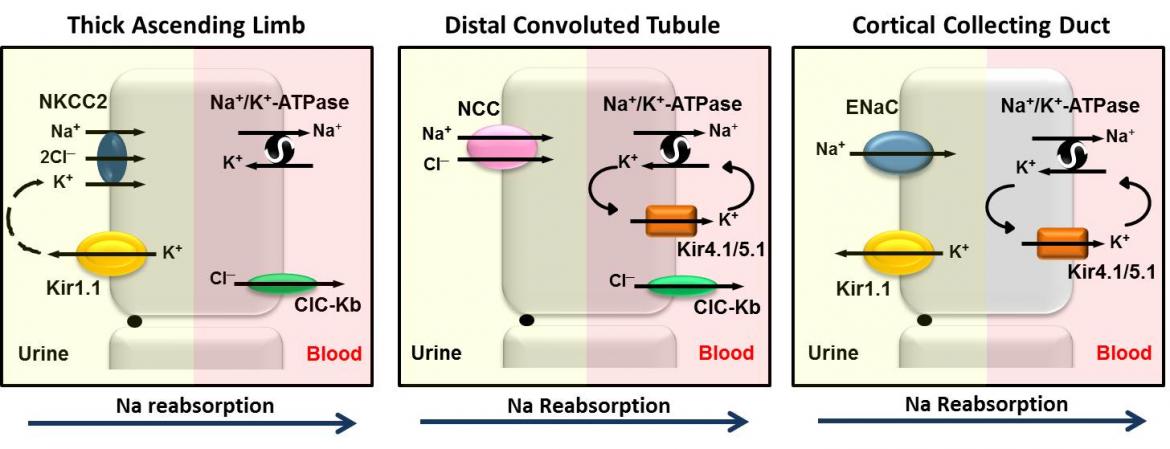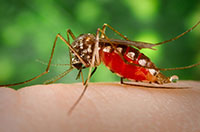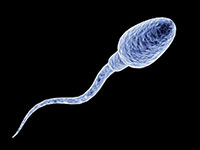Renal Kir Channels
Kir1.1 (ROMK)
The founding member of the Kir channel family, which is known as Kir1.1 or more commonly ROMK (Renal Outer Medullary K channel), is expressed almost exclusively in the nephron of the kidney where it plays key roles in regulation of blood pressure and electrolyte homeostasis. Mouse, rat, and human genetic data have suggested that pharmacological inhibition of Kir1.1 will lower blood pressure without causing potassium wasting. We and others have therefore been developing small-molecule inhibitors of Kir1.1 that can be used to evaluate the safety and efficacy of Kir1.1 inhibition in the setting of hypertension. In addition to mapping small-molecule binding sites in Kir1.1 (Swale et al., Biophys J, 2015; Kharade et al. Mol Pharm, 2017), we recentluy demonstrated that in vivo inhibition of Kir1.1 induces natriuresis and potassium sparing via inhibition of K transport in the thick ascending limb with a lesser contribution of the collecting duct (Kharade et al. AJP-Renal, 2016). We are currently exploring the integrative response to Kir1.1 inhibition under various clinically relevant conditions.
Kir4.1/5.1
Kir4.1 and Kir5.1 are expressed in the nephron where they contribute to K secretion in the distal convoluted tubule and collecting duct. Kir4.1 can be functionally expressed alone as a homotetrameric channel or as a heteromeric channel in complex with Kir5.1. Mouse and human genetic data suggest that inhibition of either channel form should induce natriuresis, diuresis, and lowering of blood pressure. We recently discovered in a high-throughput screen of ~75,000 compounds the first-in-class Kir4.1 inhibitor that is modereately selective for the homotrameric channel over the heteromeric Kir4.1/5.1 channel. We are evaluating the effects of Kir4.1 inhibition in rodent models of hypertension.
Kir7.1
Kir7.1 is one of the newest and perhaps most poorly understood Kir channel expressed in the nephron. Kir7.1-KO mice are embryonic lethal and the small-molecule pharmacology has been poorly developed. We therefore recently developed the first-in-class, sub-micromolar inhibitor of Kir7.1 termed ML418 (Swale et al., ACS Chem Neurosci, 2016). We are currently investigating how Kir7.1 inhibition alters kidney function.

Mosquito Kir Channels
Mosquitoes are the deadliest animals on earth as a result of the devastating human diseases they transmit during a blood meal. The emergence of insecticide resistance threatens currently available vector control management programs around the world, causing the need to identify novel molecular targets for the development of insecticides. Through a collaboration with Dr. Peter PIermarini at the Ohio State University and Dr. Corey Hopkins at the University of Nebraska Medical Center, we are currently developing insecticides targeting Kir1 channels expressed in the renal (Malpighian) tubules of the Zika virus vector, Aedes aegypti. We recently demonstrated that inhibition of Kir1 function induces renal failure and death in Aedes and the malaria vector, Anopheles gamiae (Swale et al., Sci Reports, 2016).

Pancreatic Kir Channels
Kir6.2/SUR1
KATP channels comprised of pore-forming Kir6.2 subunits and regulatory SUR2 subunits play key and well-defined roles in regulation of pancreatic beta-cell electrophysiology, insulin secretion, and glucose homeostasis in mammals. Gain- and loss-of-function mutations encoding these subunits cause dysregulation of glucose metabolism. We recently discovered a novel Kir6.2/SUR1 activator termed VU063, which is more potent and faster acting than diazoxide. We are currently exploring VU063 structure-activity relationships, broader selectivity, and mechanism of action.
Kir4.2
Kir4.2 is expressed in pancreatic islets, as well as other tissues, and has been associated with regulation of insulin secretion. How Kir4.2 might regulate pancreatic function is unknown. We have therefore developed Kir4.2-KO mice and a first-in-class inhibitor of Kir4.2 for exploring the channel's physiological functions.
Sperm K Channels
Sperm K channels comprised of SLO3 pore-forming subunits and regulatory LRRC52 subunits are essetial for proper sperm function and fertility. Through a collaboration with Dr. Celia Santi at Washington University, we are developing the first-in-class inhibitors and activators of SLO3/LRRC52 channels for use as non-hormonal based contraceptives.
